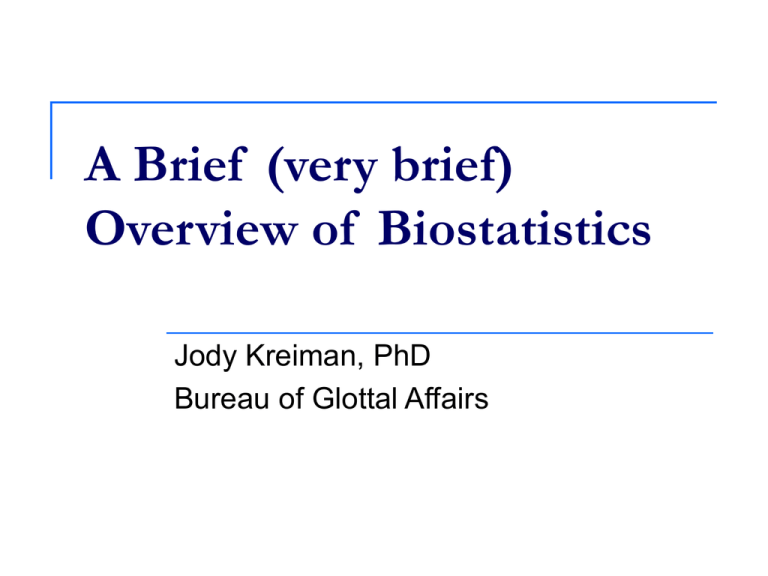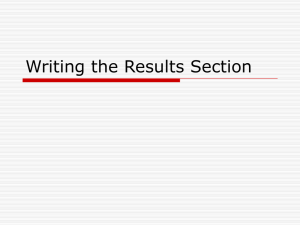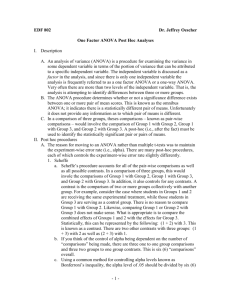
A Brief (very brief)
Overview of Biostatistics
Jody Kreiman, PhD
Bureau of Glottal Affairs
What We’ll Cover
Fundamentals of measurement
Parametric versus nonparametric tests
Descriptive versus inferential statistics
Common tests for comparing two or more
groups
Correlation and regression
What We Won’t Cover
Most nonparametric tests
Measures of agreement
Multivariate analysis
Statistics and clinical trials
Anything in depth
Why You Should Care
Without knowledge of statistics, you are lost.
It’s on the test.
I: Variables
Independent versus dependent variables
Levels of measurement
Kinds of statistics
Levels of Measurement
The kind of statistic that is appropriate
depends on the way the dependent variable
has been measured.
Four levels of measurement:
Categorical/nominal (special case: dichotomous)
Ordinal
Interval
Ratio
II. What Are Statistics?
Methods for organizing, analyzing, and
interpreting numerical data
Descriptive statistics: Organize and summarize
data
Inferential statistics: Used to make an inference,
on the basis of data, about the (non)existence of a
relationship between the independent and
dependent variables
Kinds of Statistics
When data are measured at the categorical
or ordinal level, nonparametric statistical tests
are appropriate.
Unfortunately, time prohibits much discussion of
this important class of statistics.
When data are interval or ratio, parametric
tests are usually the correct choice
(depending on the assumptions required by
the test).
Kinds of Statistics
It is always possible to “downsample” interval
or ratio data to apply nonparametric tests.
It is sometimes possible to “upsample”
ordinal or categorical data (e.g., logistic
regression), but that is beyond the scope of
this lecture.
Decisions about levels of measurement
require careful consideration when planning a
study.
Kinds of Statistics
Descriptive statistics
Inferential statistics
Descriptive Statistics
“Data reduction:” Summarize data in
compact form
Minimum
Maximum
Mean
Standard deviation
Range
Etc…
Frequency Distributions
Description of data, versus theoretical
distribution
Data can be plotted in various ways to show
distribution
Theoretical Frequency Distributions
There are lots, but we’ll stick to one for now:
the Normal Distribution
Described by a mean and a variance, about which
more later
The assumption of normality
III. Measures of Central Tendency
Mean
Median
The average, equal to the sum of the observations
divided by the number of observations (Σ(x)/N)
The value that divides the frequency distribution in
half
Mode
The value that occurs most often
There can be more than one—”multimodal” data.
Median = 204.08
Mode = about 200.00
Which to Use?
The mode is appropriate at any level of
measurement.
The median is appropriate with ordinal, interval, or
ratio data.
The mean is appropriate when data are measured
at the interval or ratio level.
The relationship between measures depends on the
frequency distribution.
When data are normally distributed, all values will be
equal.
Mean, Median, and Mode
IV. Measures of Variability
Range (largest score – smallest score)
Variance (S2=Σ(x-M)2/N)
Standard deviation
Square root of the variance, so it’s in the same
units as the mean
In a normal distribution, 68.26% of scores fall
within +/- 1 sd of the mean; 95.44% fall within +/2 sd of the mean.
Coefficient of variation = the standard
deviation divided by the sample mean
Confidence Intervals
Confidence intervals express the range in
which the true value of a population
parameter (as estimated by the population
statistic) falls, with a high degree of
confidence (usually 95% or 99%).
Example: For the F0 data in the previous
slides, the mean = 205.15; the 95% CI =
204.70-205.60; the 99% CI = 204.56-205.75.
The range is narrow because N is large, so
the estimate of the population mean is good.
V. Inferential Statistics: Logic
Methods used to make inferences about the
relationship between the dependent and
independent variables in a population, based
on a sample of observations from that
population
Populations Versus Samples
Experimenters normally use sample statistics
as estimates of population parameters.
Population parameters are written with Greek
letters; sample statistics with Latin letters.
Sampling Distributions
Different samples drawn from a population
will usually have different means.
In other words, sampling error causes sample
statistics to deviate from population values.
Error is generally greater for smaller samples.
The distribution of sample means is called
the sampling distribution.
The sampling distribution is approximately
normal.
Standard Deviation Versus Standard
Error
The mean of the sampling distribution equals
the population mean.
The standard deviation of the sampling
distribution (also called the standard error of
the mean) equals the population standard
deviation / the square root of the sample size.
The standard error is an index of sampling
error—an estimate of how much any sample
can be expected to vary from the actual
population value.
The Logic of Statistical Tests
Hypothesis testing involves determining if
differences in dependent variable measures
are due to sampling error, or to a real
relationship between independent and
dependent measures.
Three basic steps:
Define the hypothesis
Select appropriate statistical test
Decide whether to accept or reject the hypothesis
Hypothesis Testing
“If you have a hypothesis and I have another
hypothesis, evidently one of them must be
eliminated. The scientist seems to have no
choice but to be either soft-headed or
disputatious” (Platt, 1964, p. 350).
Accepting or Rejecting the Null
Hypothesis
The region of unlikely values is the level of
significance, or α. Alpha (type I error)
represents the likelihood of incorrectly
rejecting the null hypothesis.
Type II error (β) is the probability of accepting
the null hypothesis when it is actually false.
Beta is greatest when alpha is low, sample size is
small, effects of independent variable are small,
and/or sampling error is high.
Consequences of Statistical Decisions
Actual state of affairs
Decision
Null
hypothesis
accepted
Null
hypothesis
rejected
Null
hypothesis
true
Null
hypothesis
false
Correct
Type II error
Type I error
Correct
(1-β=power)
VI. Choosing a Statistical Test
Choice of a statistical test depends on:
Level of measurement for the dependent and
independent variables
Number of groups or dependent measures
The population parameter of interest (mean,
variance, differences between means and/or
variances)
Comparing Counts (Categorical Data):
the Χ (Chi)-square test
Single sample chi-square test: assesses the
probability that the distribution of sample
observations has been drawn from a
hypothesized population distribution.
Example: Does self-control training improve
classroom behavior? Teacher rates student
behavior; outcome (the observed
frequencies) compared to distribution of
behavior ratings for entire school (the
expected frequencies).
Chi-square test for two samples
“Contingency table” analysis, used to test the
probability that obtained sample frequencies
equal those that would be found if there were
no relationship between the independent and
dependent variables.
Example (de Casso et al., 2008)
Swallowing ability
Surgery
(success) in total
only
laryngectomies who did
Swallow
or did not have
radiotherapy
Solid
77%
Swallowing was
significantly better in
Soft
8%
the group that did not
receive radiotherapy
Liquid
15%
(p < .05).
Surgery
+ RT
40%
22%
38%
Comparing Group Means
Choice of test can depend on number of
groups
T-tests
Analysis of variance (ANOVA)
Calculating 95% or 99% confidence intervals
T-tests
One sample t-test
Compares sample value to a hypothesized exact
value
Example: Students with hyperactivity receive selfcontrol training and are assessed on a measure of
behavior. The experimenter hypothesizes that
their average score after training will be exactly
equal to the average score for all students in the
school.
T-tests
Two independent sample t-test
Tests hypothesis that means of two independent
groups are (not) equal.
Example: Two groups with high cholesterol
participate. The first group receives a new drug;
the second group receives a placebo. The
experimenter hypothesizes that after 2 months
LDL cholesterol levels will be lower for the first
group than for the second group.
For two groups, t-tests and ANOVAs (F tests)
are interchangeable.
T-tests
Two matched samples t-test
Tests hypothesis that two sample means are
equal when observations are correlated (e.g.,
pre-/post-test data; data from matched controls)
Example: 30 singers completed singing voice
handicap index pre- and post-treatment. The
mean score pre-treatment (42.49) was
significantly less than the mean score posttreatment (27.5; p < 0.01) (Cohen et al., 2008).
One-tailed Versus Two-tailed Tests
Comparing Group Means: ANOVA
One-way ANOVA: used when there are more
than 2 levels of the (single) independent
variable.
Tests the hypothesis that all sample means
are equal.
Statistic = F
Example: One-way ANOVA (AlQahtahi, 2005)
Fetuses hear recordings of voice, music, or
control sounds. DV=measure of change in
heart rate.
Mean changes:
Music: 4.68 (sd=10.58)
Voice: 3.54 (sd=9.99)
Control: -2.18 (sd=11.49)
The F test was significant at p < 0.05,
indicating that at least one contrast is reliable.
Multi-way ANOVA
Appropriate when there are two or more
independent variables.
Assesses the probability that the population
means (estimated by the various sample
means) are equal.
Example: Two-way ANOVA
(Zhuang et al., 2009)
Speakers with polyps, nodules, or nothing
IVs: sex, diagnosis
DVs: Two measures of air flow (MFR, PTF;
separate analyses)
Results:
Significant effects of sex and diagnosis
For PTF, post-hoc comparisons showed that only the
difference between control and polyp subjects was
significant.
For MFR, control differed from polyps, and polyps differed
from nodules, but nodules did not differ from control.
Post-hoc Tests
A significant F statistic means only that one of
the group means is reliably different from the
others.
Post-hoc tests identify which specific
contrasts are significant (which groups differ
reliably), and which do not, normally via a
series of pairwise comparisons.
Post-hoc Tests
Probabilities in post-hoc tests are cumulative: e.g.,
three comparisons at 0.05 level produce a
cumulative probability of type I error of 0.15.
So: The probability of each test must equal
α / the number of comparisons to preserve the
overall significance level (Bonferroni correction).
Example: If there are 3 groups being compared at
the 0.05 level (for a total of 3 comparisons), each
must be significant at p = 0.017. If there are 4
groups (6 comparisons), p = .0083 for each.
Post-hoc Tests
Many kinds of post-hoc tests exist for
comparing all possible pairs of means:
Scheffé (most stringent α control), Tukey’s
HSD, Neuman-Keuls (least stringent α
control) are most common.
Example: Post-hoc Tests
The significant F test in Al-Qahtani (2005)
indicated that at least one contrast was
significant.
Newman-Keuls post-hoc comparisons
showed that fetal heart rate responses to
music and voice did not differ (p=0.49), but
that both differed significantly from the control
condition (music vs. control: p<0.014; voice
vs. control: p < 0.033).
Repeated Measures Designs
Appropriate for cases where variables are measured
more than once for a case (pre-/post-treatment,
e.g.), or where there is other reason to suspect that
the measures are correlated.
Matched pair t-tests are a simple case.
Repeated measures ANOVA is a more powerful
technique.
Warning: Unless you know what you’re doing, posthoc tests in repeated measures designs require
advanced planning and a statistical consultant.
Example: Repeated Measures
ANOVA (Baker et al., 2008)
A sample of normal children each performed
4 speech tasks: sustained /a/ in isolation and
in a phrase; a repeated sentence; and
counting to 10. F0 was measured for each
task.
IVs: Task (within subjects), gender, age,
evaluating clinician
Result: A significant effect of task was
observed [F(3, 41) = 6.12, p < .01), but no
other main effects were significant.
Example: Repeated Measures
ANOVA
Post-hoc comparisons showed that F0 was
significantly higher during the counting task than
during the phrase or sentence tasks.
No other significant effects
Vowel
Phrase
Sentence Counting
Mean
240.5
236.6
235.7
246.5
SD
2.96
2.58
2.97
2.76
Correlation
Correlation measures the extent to which
knowing the value of one variable lets you
predict the value of another.
Parametric version = Pearson’s r
Nonparametric version = Rank-order
correlation = Spearman’s rho
Correlation: Example (Salamão &
Sundberg, 2008)
Thirteen choir singers produced vowels in
both modal and falsetto registers.
Measures of vocal source function were
collected, including closed quotient, H1-H2,
MFDR, etc.
Listeners judged whether the vowels
sounded modal or falsetto, and the number of
“modal” votes was counted.
Question 1: What relationships hold among
the acoustic measures?
Correlation: Example
Regression
Regression is basically the same thing as
correlation, except you get an equation that
lets you predict the exact values, rather than
just a measure of how good that prediction is.
Multiple regression: Prediction of the
dependent variable values is based on more
than one independent variable.
Regression: Example 1
Which acoustic variables are most strongly
associated with the perception of modal
versus falsetto voice quality?
Regression: Example (Taylor et al.,
2008)
Question: How well do growl F0 and
resonance frequencies predict the weight of a
dog?
Answer: Together, they predict 66.3% of
body weight [F(2, 27) = 29.48, p < 0.01); BUT
Singly, resonance frequencies are a good
predictor (R2=62.3%), but F0 is a bad
predictor (R2 = 9%).
Correlation and Regression:
Limitations
Outliers
R2 versus significance
The ‘n’ issue
Causation versus association










